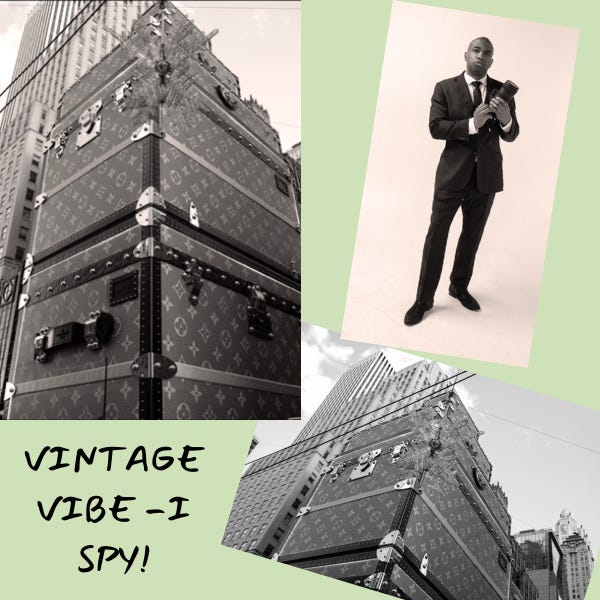LOUIS VUITTON - CHAMPS-ÉLYSÉES - 2004
I came across a photo, and it made me remember my first trip to Paris in 2004. A sun-filled day’s crisp blue sky had me walking aimlessly near the Champs-Élysées. Soaking up the ambience of Paris while peeking in shop windows, it suddenly happened! I stood paralyzed. Quelle magnifique! Not wanting to appear a tourist, I hurriedly snapped the photo of two giant monogramed trunks lodged on the Louis Vuitton headquarters on the Champs-Élysées. The large tag advertised the 150-year anniversary of the Louis Vuitton Empire. Now I confess, I’m a huge luggage freak and that was Cool! Wrapping the building with giant trunks and using them as architectural coverings during a renovation was absolutely brilliant! What a branding strategy to pay homage to LV’s origins as THE trunk maker since 1854. Had my budget been a bit more flexible, I would have gone inside and at the very least purchased a keychain to commemorate the occasion. This architectural campaign blew my mind –WOWZA!
LOUIS VUITTON - NEW YORK CITY - 2024
The Louis Vuitton flagship store on New York’s 5th Avenue again uses its distinctive construction cover - a display of six grey trunks stacked in descending size. This marketing approach continues a tradition that began with their Paris store opening in 2004, and now, twenty years later in 2024, they're using the same creative strategy during renovation work.
A New York City photographer, Tiege - known as ForzaTD - has documented this architectural transformation. His black and white photography of the construction coverings evokes a 1950s film noir aesthetic, adding an element of mystery and intrigue to the renovation process.
The renovation and its creative concealment have generated much anticipation for the store's eventual unveiling.
LOUIS VUITTON - CHAMPS-ÉLYSÉES - 2024
The iconic Louis Vuitton brand has undertaken yet another ambitious project - transforming a historic Art Nouveau building on the Champs-Élysées into a hotel. Currently, the construction site is concealed behind a massive facade featuring LV's signature monogram trunk design.
The building's history is fascinating:
In 1896, it opened as the Élysée Palace Hotel, where its most notorious guest was the famous spy Mata Hari. On February 13, 1917, French counter-intelligence officers dramatically arrested her in her luxurious hotel room. Her story came to a tragic end in October of that year - at age 41, she faced a firing squad at Vincennes near Paris. Known by her German spy code H-21, she reportedly met her fate with remarkable composure, dressed elegantly and refusing a blindfold, declaring "I am ready." (Though historians still debate whether she was actually guilty of espionage.)
After Mata Hari's time, in 1919, the building was converted into HSBC Bank's French Headquarters. Now, Louis Vuitton's transformation of the space into a hotel brings the building full circle, returning it to its hospitality roots while reflecting LV's evolution from a travel goods maker to a global luxury brand.
The project raises an intriguing question: How will Louis Vuitton incorporate this building's remarkable history - particularly the dramatic story of Mata Hari - into its new design? These walls, which once witnessed both luxurious lifestyles and moments of historical intrigue, are about to become part of French luxury's next chapter.
The Louis Vuitton Hotel is scheduled to open its doors in 2026.
I smell a road trip! -B







